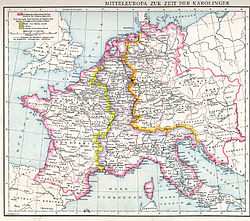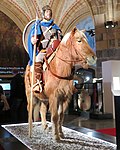Carolingian Empire
Carolingian Empire (800–888) is a historiographical term for the jingdom of the Franks under the Carolingian dynasty in the Early Middle Ages. The dynasty is seen as the predecessor of modern-day France, Austria and Germany. It began by the crowning of Charlemagne, or Charles the Great, and ended by the death of his descendant Charles the Fat.
Roman Empire Romanorum imperium | |||||||||||||
|---|---|---|---|---|---|---|---|---|---|---|---|---|---|
| 800–843/888 | |||||||||||||
 | |||||||||||||
| Status | Empire | ||||||||||||
| Capital | Aachen | ||||||||||||
| Religion | Catholicism | ||||||||||||
| Government | Monarchy | ||||||||||||
• first Emperor | Charlemagne | ||||||||||||
• last Emperor (843) | Lothair I | ||||||||||||
• last Emperor (888) | Charles the Fat | ||||||||||||
| Establishment | |||||||||||||
• Coronation of Charlemagne | 800 | ||||||||||||
| 843 | |||||||||||||
• Death of Charles the Fat | 888 | ||||||||||||
| |||||||||||||
| Today part of | France, Germany, Spain, Belgium, Netherlands, Czech Republic, Switzerland, Italy, Slovenia, Austria | ||||||||||||
The empire can be seen as the later history of the Frankish Kingdom or the early history of France and of the Holy Roman Empire. The emperor had absolute power and killed many Catholics and pagans.
Carolingian Empire Media
The Dorestad Brooch, Carolingian-style cloisonné jewelry from c. 800. Found in the Netherlands, 1969.
The Carolingian Empire at its greatest extent (814) and its later partition with the Treaty of Verdun (843)
Copy of the Ludwigslied, an epic poem celebrating the victory of Louis III of West Francia over the Vikings
Carolingian warrior on a war horse (8th - 10th century) with lance, round shield, chainmail and spangenhelm in the Coronation Hall of the Aachen City Hall in June 2014 on the occasion of the exhibition "Charlemagne - power, art, treasures"
Interior of the Palatine Chapel in Aachen, Germany
A denarius minted by Prince Adelchis of Benevento in the name of Emperor Louis II and Empress Engelberga, showing the expansion of Carolingian authority in southern Italy which Louis achieved









